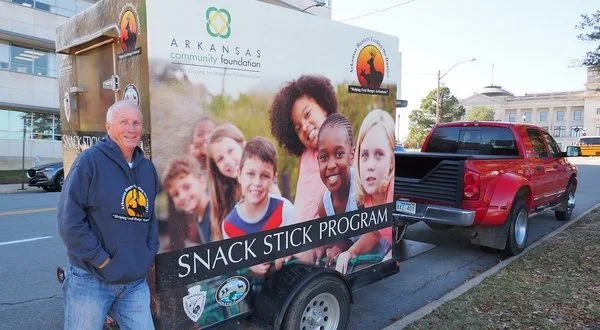
Ronnie Ritter, executive director of Arkansas Hunters Feeding the Hungry, leans against a refrigerated trailer that he drives across the state to hunting clubs. The deer are processed into snack sticks, which have become a staple in schools backpack programs over the last six years. Photographed Dec. 6, 2024. (Mary Hennigan/Arkansas Advocate)
On paper, it seems like Ronnie Ritter is a one-man operation.
But while he’s the only person on staff at Arkansas Hunters Feeding the Hungry, Ritter’s innovations have amassed statewide support from deer processors, food pantries, school districts and hunting clubs to fight hunger in Arkansas, where food insecurity ranks worst in the nation.
The nonprofit launched in 2000, and Ritter has helped proffer more than 1.5 million pounds of venison to people in need, whether it be through fresh ground meat or a jerky product. Programs that Ritter once considered a dream have helped regulate the state’s deer population and provide hard-to-get protein to vulnerable Arkansans, children included.
“It’s a passion,” said Ritter, who has 17 years with the organization. “My wife and I consider it a ministry because we’re working with the local churches, schools and getting food to kids.”
At nearly 19%, Arkansas reported the highest food insecurity rate in the nation in 2023, according to an annual U.S. Department of Agriculture report. The study supported previous data from Feeding America, a nonprofit that found one in four Arkansas children lacked access to healthy food in 2022.
The high rate caught the attention of the state’s top leaders. Last year, Gov. Sarah Huckabee Sanders was one of three dozen state governors to opt into the federally funded Summer EBT program that gave qualifying students $120 for groceries during the summer months; shes already pledged to participate again.
State department secretaries were also ordered last year to identify policies that may be contributing to, or exacerbating, food insecurity in Arkansas. Based on departmental reports, the governor’s office will develop a plan for repealing or amending regulations, according to an executive order.
At the start of the ongoing 95th General Assembly, Sanders named addressing food insecurity as one of her legislative priorities. In addition to proposals to encourage schools to purchase their food in-state, Sanders also said she supports using funding from the medical marijuana industry to provide children with free breakfast.
Childhood hunger
At Malvern Elementary School in Hot Spring County, counselor Stephanie Sawyer knows kindergarteners who, too young to verbalize their circumstance, steal food off their classmates’ trays, scarf down their lunch as fast as possible or sneak into their teacher’s snack drawer.
“Some of our brightest, highest-achieving kiddos are these kids, and it just breaks your heart because it’s like, how much more could they do?” Sawyer said. “…I want to give them everything that I can now, because I see how much potential you have, and I don’t want you to have to worry about the basic necessities.”
During an annual Christmas program she organized in December, Sawyer said 2024 was the first year students listed food as something they wanted for the holiday season.
Food hardships do not affect children equally, and according to a 2024 Annie E. Casey Foundation report, children who lack reliable access to adequate food are more likely to experience negative health outcomes and lifelong consequences. Being food insecure can also cause children to perform worse in school and lower their chances of graduating, according to the report.
“They’re not going to raise their test scores if they’re worried about what they’re going to eat tonight, or worried about not having a jacket to wear when it’s cold,” Sawyer said.
Malvern, a rural town in Central Arkansas, has a poverty rate of about 21%, according to the U.S. Census. Its elementary school is among dozens of schools statewide that receive donations from Arkansas Hunters Feeding the Hungry, and the shelf-stable snack stick has become a staple for its backpack program.
“When they first contacted me about the sticks, I was excited,” said Phyllis Murdock, a parent coordinator for Malvern Elementary who leads the backpack program. “And then when the kids started getting it, they were excited. I think it’s a worthwhile program.”
Murdock, 68, has worked with the Malvern school district for at least a dozen years, and she currently prepares weekly backpacks for 110 students, she said. Her most recent delivery of snack sticks just ran out, and she said she’s hoping for more.
The Arkansas Department of Education reports Malvern elementary serves nearly 700 children, which means about 15% of its kindergarten through fourth grade students depend on the backpack program for food during weekends and holidays.
Arkansas Hunters Feeding the Hungry has distributed more than 500,000 snack sticks in the last six years, mostly to hungry children. Ritter said he personally delivered about 150,000 last year, and the demand exceeds the organization’s supply.
“Rarely do they get something like this – it’s just a bonus for them – because protein is one of those elements sometimes lacking in that backpack,” Ritter said.
Unlike other common proteins, Ritter’s snack sticks don’t have to be refrigerated or cooked. They’re also discrete enough for children to hide in their backpacks in addition to or in lieu of the backpack program, which Sawyer said is important for the kids who have siblings or prideful parents.
“Sometimes our parents are too prideful and they don’t want you to know that they’re struggling,” she said. “But the kids, they’ll sure let you know. So we just kind of sneak some stuff, and that’s where the meat sticks can be great because those are small and they’re not having to find a microwave to warm it up or put it in their fridge to keep cold.”
One innovation after another
When Arkansas Hunters Feeding the Hungry started at the turn of the century, the organization only offered ground deer meat donations to food banks and pantries. Snack sticks have since expanded the program, and Ritter’s innovative spark sprouted again in October when he introduced a refrigerated trailer service to hunting clubs.
“This first year, we thought, ‘OK, we’ll kind of ease into it,” Ritter said of himself and the nonprofit’s board of directors. “But it hasn’t eased, which is good, it’s just that we need to figure out a process.”
Each trailer can easily fit 30 field-dressed deer inside, Ritter said. The animals are tested for chronic wasting disease, tagged and processed into ground meat or snack sticks. In a few short months, Ritter said the organization had already received at least 400 “extra deer that we wouldn’t have gotten before.”
The word among hunting clubs spread quickly, and Ritter said he began fielding constant calls from clubs that wanted to participate. Already, Ritter sees the need for more trailers and resources.
The “extra” deer are mostly turned into protein sticks, while the deer that are traditionally donated to the organization lead the ground meat program. Producing the snack sticks includes a 16-hour round trip to a processor in Missouri, because no one in Arkansas makes shelf-stable products at the volume Ritter needs, he said.
“There’s a few that are kind of getting into this, but I can’t drop off a ton of meat and say, ‘Make me 20,000 packages.’ They just don’t have the facility to do it,” Ritter said.
Arkansas Hunters Feeding the Hungry relies on grants and donations to stay in operation. Residents who apply for a hunting license are prompted to donate to the organization, and Ritter said he writes and receives a lot of grants, especially if they’re related to food insecurity.
It takes $250,000 a year for the organization to operate, which Ritter said is “not a lot, but it’s a lot when you’re trying to raise it all.”
The jerky products don’t provide the organization with any profits; the $1 cost per snack stick may even be a small deficit, Ritter said.
Community impact
Each deer donated to Arkansas Hunters Feeding the Hungry is processed and returned to the area it was hunted. By partnering with about 70 deer processors statewide, Ritter said his products are passed through approximately 150 food pantries and into underserved communities.
Becky Chote, assistant director at the Project HOPE Food Bank in Hot Springs, said she and a group of volunteers work with 70 different nonprofit agencies to distribute food, including products from Ritter. The food bank also works in coordination with 13 surrounding school districts’ backpack programs, which partner with nonprofits to ensure the products are free for students.
The programs are successful, but the increased number of participants means more people are experiencing food insecurity.
“We’ve seen a 30% increase over last year, which is huge for us because we are a small, independent food bank,” Chote said. “…Hunger is definitely getting worse, and the unfortunate thing is the SNAP (Supplemental Nutrition Assistance Program) benefits that many families get for their children are not keeping up with the rising cost of food.”
According to a recent report from Arkansas Advocates for Children and Families, more than 400,000 Arkansans relied on SNAP in 2023, which was formerly known as the Food Stamp Program. SNAP-eligible Arkansans currently must have a gross income below 130% of the federal poverty guidelines.
The Arkansas Department of Human Services reported nearly 128,000 households that were reliant on SNAP as of Jan. 29, spokesperson Gavin Lesnik said.
Ritter and Arkansas Hunters Feeding the Hungry provide most of its ground venison during deer season from September to February when supply is plentiful. The jerky snack sticks are deliverable year-around because of their nine-month shelf life.
Chote said the Hot Springs food bank receives an estimated 6,000 pounds of ground deer meat through the winter months and snack sticks on an ongoing basis.
“Those are about the greatest thing for kids because that’s what a lot of times they lack at home, is protein,” Chote said. “So many of our kids have grown up on carbs and sugar, and good, clean protein, especially when it’s that tasty, is really nice.”
Children are the primary focus when it comes to the jerky products, but Chote said she knows the older population who live on a fixed income are grateful for the nutritious ground meat that sparks nostalgia.
“Some of the people we distribute it to are old timers that have spent their lives using game as protein, and so they just treasure this stuff,” Chote said.
To view this story, or more news updates from Arkansas Advocate, click here.
WebReadyTM Powered by WireReady® NSI










